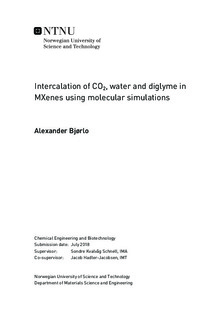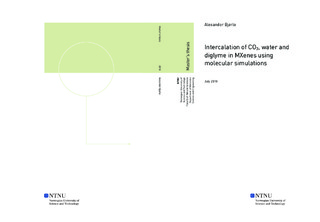| dc.description.abstract | Since its discovery in 2011, MXenes have gained a lot of attention for their application in energy storage. Their combination of being a two dimensional material, as well as having excellent electronic and mechanical properties, makes them an interesting material for electronic energy storages, as well as for \ce{CO2} capture. This is emphasized the weak Van der Waals forces between the layers. Both small ions and large organic molecules have been successfully intercalated between the MXene layers. MXenes are hydrophilic, and water intercalate easily between their layer. This can be problematic for its applications in energy storage, where water may be present.
This study investigates the adsorption properties of \ce{Ti2C} MXenes terminated with Fluor and Oxygen. This is done using Monte Carlo methods and Molecular dynamics simulations in the osmotic ensable. The adsorbates studied are the two water models SPC/E and TIP5p, Diglyme and \ce{CO2}. The simulations are performed at small pressure discretizations in a flexible multilayered MXene framework. The simulations are performed with the software package RASPA. The simulations show many uncertainties, although some results were gathered. The adsorption of water was found to be higher than the adsorption of \ce{CO2}, which corresponds well with the hydrophilic nature of MXenes. Results suggests that the adsorption was a physical adsorption, by evaluating the isosteric heat of adsorption, although the isosteric heat of adsorption shows nonphysical behaviour. Diglyme was not adsorbed to the framework at any temperatures, which most likely is due to the unit cell volume being close to constant throughout the simulation. This is the case for all of the adsorbate-adsorbent systems simulated. The adsorption of SPC/E water, TIP5p water and \ce{CO2} were most likely limited by kintetics at low temperatures, and thermodynamics at high temperatures. This contradicts with the Monte Carlo methods, which should not be restricted by kinetics. The simulations performed, although some evidence of adsorption were observed, are most likely not of any significance. This is due to several nonphysical phenomena observed. These phenomena are probably due to too few Monte Carlo cycles, and viable results may be obtained using several more cycles. | |

